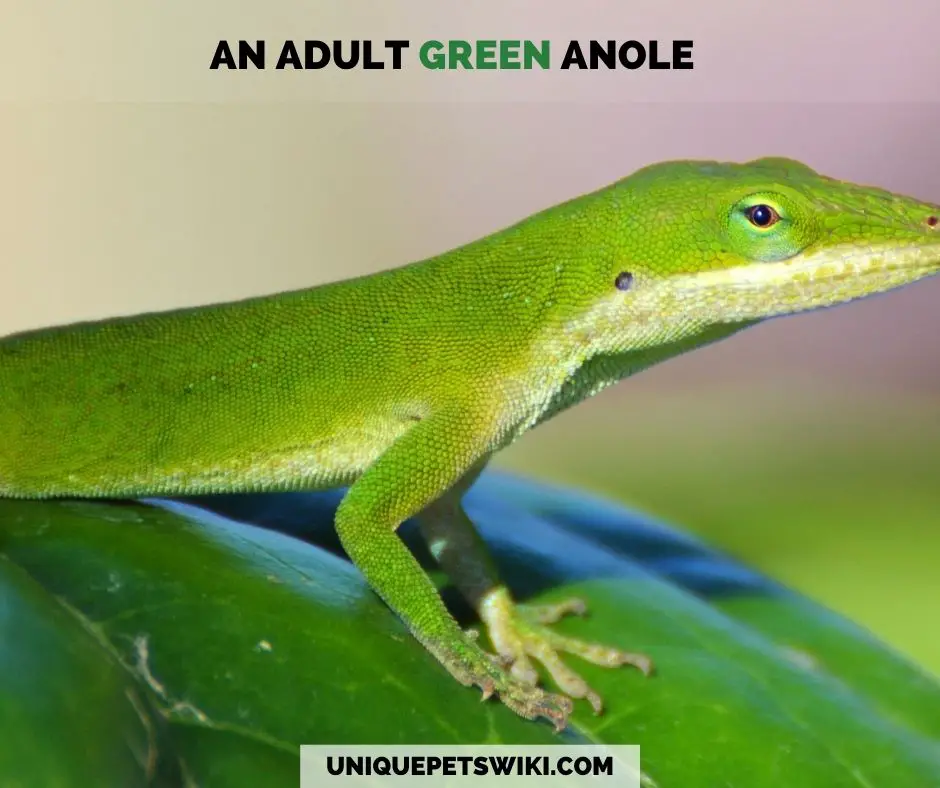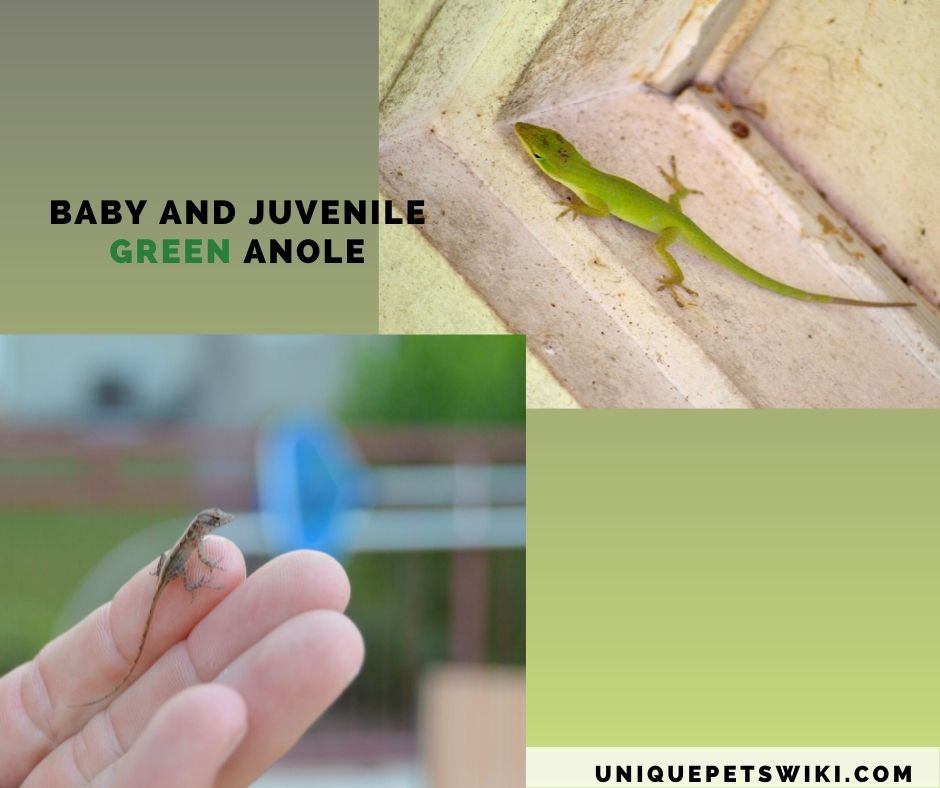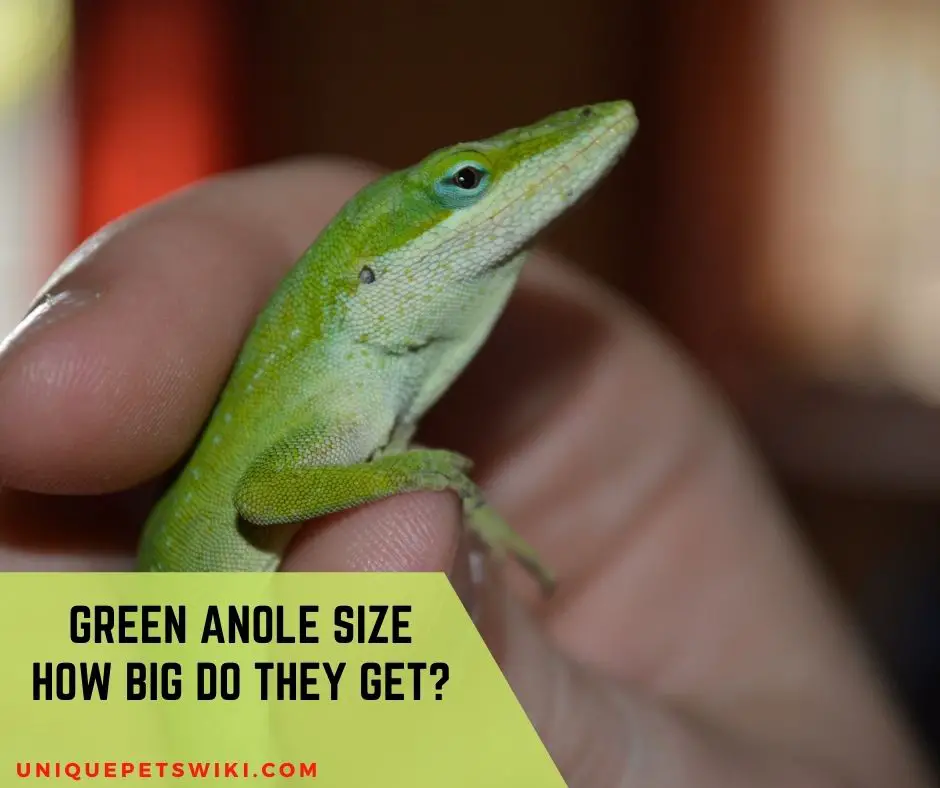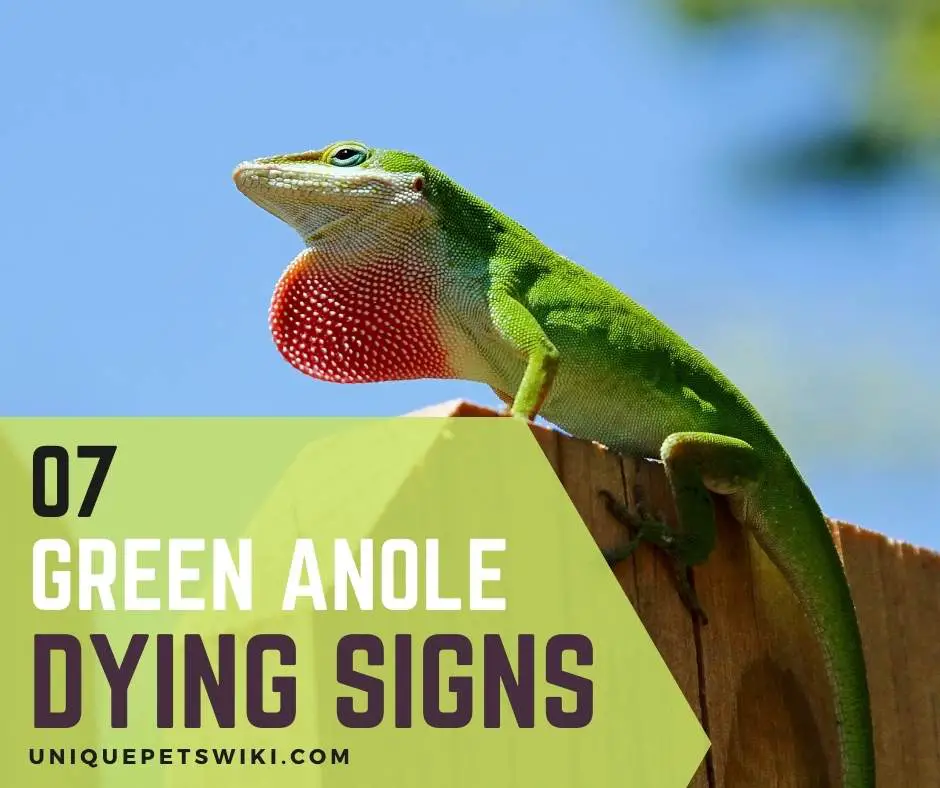Exotic pets require special needs compared to domestic pets. It is because it is inevitable for their owners to make their habitat fit and comfortable.
For these reasons, the pet’s size is significant, especially when preparing how to care for your pet. Some factors, such as the size of the tank, depend entirely on the pet’s size.
Many people don’t know how big their green anoles can get. As a result, they end up buying either small or excessive tanks for their green anoles.
Therefore, we came up with this article to help you understand how big a green anole can get.
Additionally, we will give you a chart showing their expected growth rate. And give you factors that may determine the size of your green anole.
You surely don’t want to miss this one. Keep reading!
Contents
Green Anole Size: How Big Do Big Anoles Get?
Age, sex, and species are the major factors that affect the size of the green anoles. For instance, male green anoles can grow for up to 8 inches.
On the other hand, the female green anoles rarely exceed 5-6 inches. Again, it’s common sense to know that baby green anoles are small and are usually 1 inch at hatchling.
The size of the fully grown green anole again depends on their species. Thus, let’s look at the size of the green anoles depending on the breed and age.
Juvenile Green Anole Size
Juvenile green anoles are anoles that are past the age of babies but are not sexually mature.
The size of juvenile green anoles may differ depending on the behavior, sex, and species.
In most cases, juvenile green anoles will have a snout-vent length (SVL) measurement of 23-42mm.
The juveniles continue growing fast. Unlike adults, they do not engage in territorial fights but concentrate more on foraging.
Baby Green Anole Size
Green anoles are typically small or medium-sized lizards. A hatchling, they are born measuring only one inches.
Their growth rate is slow as they only get to a maximum length of 4-8 inches when fully grown.
Green amoles are sexual dimorphism. Thus, the males get larger compared to females.
But, as babies, it is impossible to differentiate between males and females. However, as they continue growing, males start portraying territorial characteristics.
Green Anoles Sizes by Breed
There are two main subspecies of green anoles, A. carolinensis and A. Seminoles.
They have the same similarities, including their size except for their color. They both measure 4-8 inches long when fully grown.
However, green anoles or A. Carolinensis can change their color depending on their mood.

Adult green anoles live in trees and bushes. On the contrary, brown anoles live on grounds where their color can match their environment.
Green Anole Growth Rate
The green anole’s growth rate is determinate. Thus, green anoles grow at a constant rate till they are adults.
Green anoles continue growing even after reaching maturity. However, during the breeding period, male green anoles do not register any growth rate.
They concentrate most of their time in territorial fights and mating and less time in foraging.
On the other hand, females do not participate in territorial fights. Thus, they continue growing even during the breeding season.
Hatch
A hatchling, green anoles are only 23-25mm long. Though tiny, they resemble their parents except that they are brownish and have short tails and large heads.
But, even though they are pretty tiny at this stage, they don’t need parental guidance to survive.
They grow to juveniles and even to adulthood on their own. The basic needs for juveniles and adults are the same.
However, baby anoles require you to feed them tiny insects such as fruit flies, baby crickets, and springtails.
Baby green anoles can quickly dehydrate. Thus, you should provide them with a drop of water on the tip of their nostril using an eyedropper until they can drink water on their own.
Once they can drink water independently, you should continue offering them water by leaving drops on leaves and other decorations.
Baby anoles fight each other and adults can also eat them. Therefore, it would be best if you kept them separately.
However, since baby anoles grow fast, quite a number will survive and grow to adults even under these circumstances.
Juveniles

Green anoles develop pretty fast. Two weeks after hatchling, green anoles start hunting for their food.
Green anoles remain juveniles until they reach a maturity age of 18 months. Behavior patterns can affect Juvenile growth rate.
For instance, male juvenile green anoles actively forage more than females. As a result, male juvenile green anoles grow bigger compared to juvenile females.
Adult
Green anoles sexually mature within 12-18 months. Thus, their growth rate is relatively fast compared to most other pets.
Green anoles also have a short lifespan. As such, they attain their sexual maturity fast.
Male adult green anoles are pretty territorial. As such, their growth rate is quite significant.
For this reason, small male green anoles, even though they may reach sexual maturity at SVL 30-39mm, they rarely engage in mating.
Instead, they put energy into growing to defend their territory. Female and green anoles do not register much growth rate during mating.
How Big Will My Green Anole Be?
Green anoles are medium-sized lizards. As such, they do not grow beyond 8 inches. Several factors can affect green anoles growth rate.
These factors may include
- Feeding rate
- Green anoles activities
- Breeding seasons
- Habitation
Green Anole Growth Rate Chart
| Age (Months) | Size (Inches) | Weight (Grams |
| 1 | 1 | 0.75 |
| 2 | 1.4 | 1.05 |
| 3 | 1.8 | 1.35 |
| 4 | 2.2 | 1.65 |
| 5 | 2.6 | 1.95 |
| 5 | 3.0 | 2.25 |
| 7 | 3.4 | 2.55 |
| 8 | 3.8 | 2.85 |
| 9 | 4.2 | 3.15 |
| 10 | 4.6 | 3.45 |
| 11 | 5.0 | 3.75 |
| 12 | 5.6 | 4.2 |
| 12+ | 6.0-8 | 4.5-6 |
For more information on green anole size visit ResearchGate.
Factors That Affect Green Anole Size
Many factors can influence the size of the green anole. In this section, we will discuss some of those factors.
Genetics
Some green anoles are big, while others are small. The size of their bodies is due to genetic factors.
Unfortunately, small green anoles, either male or female, encounter multiple issues during breeding.
Small males encounter difficulty in mating as larger males heavily fight them.
On the other hand, small females also encounter difficulties as their bodies are too small to hold eggs.
Gender
Green anoles are dimorphism sexually. Therefore, the males tend to get larger than females.
Males must get larger for them to protect their territory. Small males rarely get to mate even though they have their sperms ready.
It is because male anoles must engage in a territorial fight before mating their female.
Diet
Diet is also significant when it comes to green anole size. Lack of proper diet can lead to poor health and retarded growth.
For this reason, it is critical to ensure that your green anole can access a proper diet at all times.
Green anole’s diet includes small invertebrates such as crickets, worms, ants, butterflies, flies, and small slugs.
Housing
A warm and humid habitat should make an ideal habitat for your green anole. It should have a temperature ranging between 85 and 900F at the top and 75-850F at the bottom.
Improper housing can lead to health issues and, in return, loss of weight. It can also cause stress to your green anole.
Husbandry
Stress can significantly cause ill health and loss of weight in green anoles. As such, it is critical to maintaining a suitable habitat for your green anole.
A suitable habitat should have hiding places, live plants, 2-3 inches substrate, ideal temperature, and proper lighting.
A good thumb of rule is to provide a habitat similar to your green anole natural environment.
Green Anole Weight
Adult green anoles weigh 2 to 6 grams. You don’t have to worry about your green anole with a proper diet, getting over or underweight.
It would help if you fed adults every other day. Three to four worms or insects should be adequate per feed.
However, the babies need you to feed them every day. And brush their feed with calcium and vitamin supplements.
Can Green Anole Overweight or Underweight?
Overfeeding or underfeeding can lead to several issues in green anoles. Underfed green anoles get skinny and appear physically unhealthy.
On the other hand, overfed green anoles get fat and can lead to death. Therefore, it is critical to ensure you feed only the required amount of feed to your green anoles.
How Can I Tell If My Green Anole is Overweight
Green anoles store the fat in their tails. Thus, if your green anole seems to have an overly fat tail, it could be it is overweight.
In such cases, you need to reduce the amount of food you offer your green anole until they regain the appropriate body weight.
How Can I Tell If My Green Anole is Underweight?
Underweight green anoles are unhealthy and look impoverished. You can tell if your green anole is underweight or impoverished if they are inactive, always hiding, skinny, dropped tail, or not eating.
They can also have a solid brown color that does not return to green.
Wrapping Up
Green anoles are beautiful and make wonderful pets. However, they are not beginner-friendly.
Lack of proper habitat can cause acute stress. In return, they may turn brown or even drop their tail.
A drop of tail affects green anole’s size as their body length is equivalent to the size of their tail.
Even though it can be challenging to care for green anoles, it still pays back every struggle as they are fun to own.

